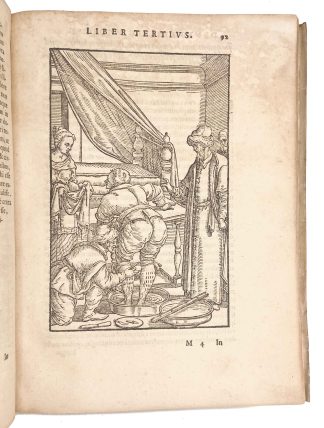ALPINO, Prospero
EARLY EUROPEAN STUDY ON EGYPTIAN MEDICINE
De medicina Aegyptorium, libri quatuor
Venice, apud Francesco De Franceschi, 1591£3,950.00
FIRST EDITION. 4to. ff. (xii) 150 (xxvi). Roman letter, little Italic. Woodcut vignette to t-p, 6 woodcuts (full- to ¼-page) showing body parts and medical scenes, decorated initials, head- and tailpieces. T-p a bit soiled, varying degrees of age browning, C19 steel-engraved author’s portrait tipped-in before t-p. A good copy in contemporary limp vellum, traces of ties. Modern bookplate to front pastedown, C18-C19 bibliographic annotations to fep and rear pastedown, very occasional early annotations.
A well-margined copy of this remarkably influential medical treatise—‘one of the earliest European studies of non-Western medicine’ (Norman 39) interpreted not as a different tradition but as a parallel system of practices that could be compared to Western ones, sometimes through the work of Venetian colleagues. Prospero Alpini (1553-1617) was a Venetian physician and botanist whose fame led to his appointment as prefect in charge of the botanical garden in Padua, one of the oldest in the world, and professor at the same university. His numerous works concerned with medicine and botany were greatly influenced by his travels in Egypt in the early 1580s, as personal physician to Giorgio Emo, Venetian Consul at Cairo. ‘De medicina Aegyptiorum’ is entirely devoted to the medical customs of Egyptians, and structured in the form of a dialogue between Alpinus and the botanist Melchior Guilandino. The first section discusses the state of art of Egyptian medicine, the most frequent illnesses and epidemics. A substantial part was devoted to the plague, its recent manifestation in Cairo (with half a million victims) and its transmission (through contagion from Greece, not as believed in natural cycles of seven years). ‘For European readers with much more than an academic interest in questions of the origin and means of transmission of the plague, Alpini’s views remained points of reference and contention well into the nineteenth century’ (Seth, ‘Difference and Disease’, 35). The second, third and fourth sections are devoted to medical practice. Alpinus was critical of the Egyptian practice of blood-letting, to which a handsome full-page woodcut is devoted; in his opinion it was used too often (even on children) and the amount of blood let was excessive. He compared Egyptian techniques and practices to those of Venetian colleagues. His examination of various conditions, procedures and treatments is interwoven with considerations on the importance of diet, the positive or detrimental consumption of specific fruit and vegetables and the use of ‘decocti’ for therapeutic purposes. The most important example—the explanation of how to prepare ‘choua’, which tastes like chicory—is also the first appearance of coffee in print. Alpinus calls it the seed of a tree he saw growing in the orchard of the Turkish sultan; he guides the reader through the brewing procedure made by a filtering process. It could benefit women with menstruation, as a facilitator of purgation, and was generally drunk quite liberally, like wine in the West, at public taverns. The work includes a Tharachfaruc, a list of drugs and antidotes which he compares to the ‘Theriaca Andromachi’ used in Venice. The early annotator of this copy was particularly interested in the preparation and therapeutic use of cannabis. A ground-breaking work which brought to the West new treatments, medical theories and comparative practices; it still held a safe place on the shelves of C18 and C19 physicians.
BM STC It., p. 20; Adams, A802; Mortimer, Harvard C16 It., 16; Heirs of Hippocrates, 240 (1646 ed.); Osler, 1796; Durling, 178; Wellcome I, 232; Garrison-Morton, 6468 (‘First important work on the history of Egyptian medicine’); Simon II, 42. S. Seth, Difference and Disease (Cambridge, 2018).In stock






